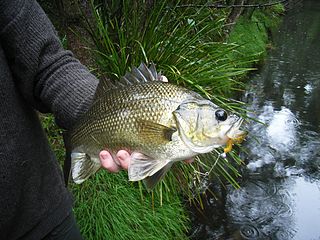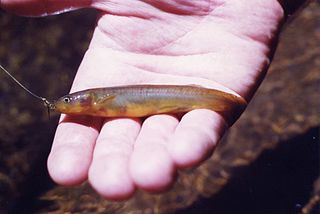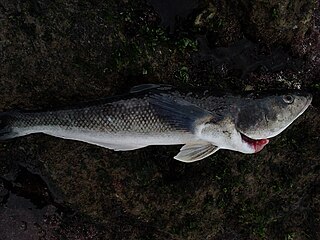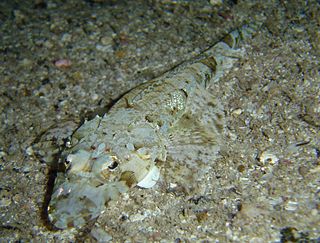
The members of the family Percichthyidae are known as the temperate perches. They belong to the order Perciformes, the perch-like fishes.

A flathead is one of a number of small to medium fish species with notably flat heads, distributed in membership across various genera of the family Platycephalidae. Many species are found in estuaries and the open ocean in the Indo-Pacific, especially most parts of Australia where they are popular sport and table fish. Flathead can grow at least 1 metre (3.3 ft) in length and 18 kilograms (40 lb) in weight, with dusky flathead being the biggest, although fish this size are seldom caught.

The Australian bass is a small- to medium-sized species of primarily freshwater fish found in coastal rivers and streams along the east coast of Australia. A member of the genus Macquaria from the family Percichthyidae, the Australian bass is an important member of the native fish assemblages found in east coast river systems. It is a native predatory fish and an extremely popular game fish species among anglers. The species was simply called perch in most coastal rivers where it was caught until the 1960s, when the name "Australian bass" started to gain popularity.
The Old World silversides are a family, Atherinidae, of fish in the order Atheriniformes. Atherinidae are abundant and considered bony fish (teleost) that are widespread globally, living in rivers, estuaries, and coastal waters. They occur worldwide in tropical and temperate waters. About two-thirds of the species are marine, and the remainder live in fresh water. The 74 species are in 13 genera. The genus Craterocephalus is the most diverse with 25 species. Four genera are monotypic.

Notothenioidei is one of 19 suborders of the order Perciformes. The group is found mainly in Antarctic and Subantarctic waters, with some species ranging north to southern Australia and southern South America. Notothenioids constitute approximately 90% of the fish biomass in the continental shelf waters surrounding Antarctica.

Aplodactylus is a genus of marine ray-finned fishes, commonly known as marblefishes or sea carps. It is the only genus in the monogeneric family, Aplodactylidae. The fishes in this genus are found in the south eastern Indian Ocean and the southern Pacific Ocean.
The Bathydraconidae, or the Antarctic dragonfishes, are a family of marine ray-finned fishes, notothenioids belonging to the Perciform suborder Notothenioidei. The family comprises four genera. These fishes are endemic to deep waters off Antarctica.

Bovichtidae, the temperate icefishes or thornfishes, is a family of marine ray-finned fishes, classified in the suborder Notothenioidei of the order Perciformes. They are native to coastal waters off Australia, New Zealand, and South America.

The flathead grey mullet is an important food fish species in the mullet family Mugilidae. It is found in coastal tropical and subtropical waters worldwide. Its length is typically 30 to 75 centimetres. It is known with numerous English names, including the flathead mullet, striped mullet, black mullet, bully mullet, common mullet, grey mullet, sea mullet and mullet, among others.

The Pacific staghorn sculpin is a species of marine ray-finned fish belonging to the family Cottidae, the typical sculpins. This species is found in the eastern Pacific Ocean. It is the only species in the monospecific genus Lepidocottus.

Galaxias is a genus of small freshwater fish in the family Galaxiidae, and are frequently referred to as the galaxiids. These highly adaptable fish are typically found at temperate latitudes across the Southern Hemisphere.

The Glenelg River, a perennial river of the Glenelg Hopkins catchment, is located in the Australian states of Victoria and South Australia.

Platycephalus is a genus of mostly marine, demersal ray-finned fish belonging to the family Platycephalidae. They are found in the eastern Mediterranean, the Indian Ocean and western Pacific Ocean.

Tetraroginae is a subfamily of marine ray-finned fishes, commonly known as waspfishes or sailback scorpionfishes, belonging to the family Scorpaenidae, the scorpionfishes and their relatives. These fishes are native to the Indian Ocean and the West Pacific. As their name suggests, waspfishes are often venomous; having poison glands on their spines. They are bottom-dwelling fish, living at depths to 300 metres (980 ft). These creatures usually live in hiding places on the sea bottom.

The Artedidraconidae, barbeled plunderfishes, are a family of marine ray-finned fishes, notothenioids belonging to the Perciform suborder Notothenioidei. The family comprises four genera. These fishes are endemic to deep waters off Antarctica.

The Patagonian blennie, also known as the rock cod, is a species of marine ray-finned fish, belonging to the monotypic family Eleginopidae and monotypic genus Eleginops. It is found in coastal and estuarine habitats around southernmost South America.

Cymbacephalus is a genus of marine ray-finned fishes belonging to the family Platycephalidae, the flatheads. These fishes are found in the Indo-Pacific region.

Bovichtus is a genus of fish in the family Bovichtidae found in the Atlantic, Indian and Pacific Ocean.
The flathead congoli is a species of marine ray-finned fish, belonging to the family Bovichtidae, the thornfishes or temperate icefishes. It is native to the seas off southeastern Australia. This species is the only known member of its genus.

















